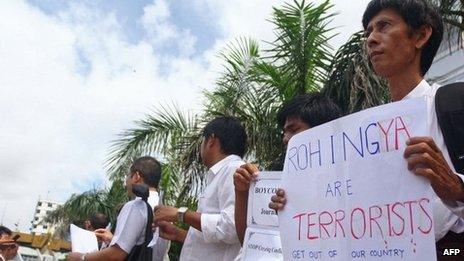Old tensions bubble in Burma
-
Published

For decades the fear and hatred has simmered, but rigid military control has largely kept it in check.
Now, as Burma enters a new era of liberalisation, decades of pent-up feelings have exploded into sectarian violence.
Buddhists and Muslims in Rakhine state have attacked each other, prompting the government to declare a state of emergency and impose a dusk-to-dawn curfew in several areas.
President Thein Sein has warned of an unravelling of the country's democratic transition in the face of inter-communal violence.
"If this endless anarchic vengeance and deadly acts continue, there is the danger of them spreading to other parts and being overwhelmed by subversive influences," he said on Sunday.
"If that happens, it can severely affect peace and tranquillity and our nascent democratic reforms and the development of the country."
Opposition leader Aung San Suu Kyi met Muslim leaders in Rangoon earlier this week and issued a similar appeal for tolerance.
History of hatred
Local Buddhists blame the Muslim Rohingya people for the outbreak of violence, which appears to have started when a woman was raped and killed. Three Muslim men are in custody following the attack.
In what seems to have been a revenge attack, 10 Muslims were killed in an attack on a bus.
But whatever the cause of the latest clashes, the conflict between Buddhists and Muslims in Rakhine state has deep roots.
During the Second World War and again in the early 1990s, sectarian violence claimed many lives.
One of the most worrying trends is the appearance on placards and on the internet of demands for Rohingyas to be removed from Burma. Under the country's constitution they are denied citizenship.
There are an estimated 750,000 Rohingyas in Rakhine state, but they are frequently referred to as "Bengalis" who belong in neighbouring Bangladesh.
As a former Burmese foreign minister reportedly once remarked: "Historically, there has never been a Rohingya race in Myanmar [Burma]."
But the Rohingya are also stateless in Bangladesh, where many thousands have sought refuge from persecution in Burma.
The campaign group Human Rights Watch said discriminatory government policy in Burma had helped inflame tensions.
The organisation said the government's handling of the latest crisis would be a critical test of its reform program.
Elsewhere there has been progress in negotiating an end to some of the other ethnic problems that have plagued Burma since independence, although the situation in Kachin state remains hugely problematic.
Newfound freedoms
So how great a threat to the transition is the violence in Rakhine state?
If the violence was happening in isolation then the threat could be regarded as relatively small.
But for a country emerging from nearly 50 years of military domination, with different groups testing the limits of freedom, the current position is potentially precarious.
In recent months there has been a series of labour disputes and protests over power shortages that would have been unthinkable under the old dispensation.
The demonstrations certainly reflect a more tolerant state, but also a flexing of muscle on the part of a previously quiescent people who are frustrated with poverty and lack of development.
Set against all this is the emergence of the National League for Democracy (NLD) as a potent electoral force.
It won 43 out of the 44 seats it contested in recent by-elections, a result that surprised the military backed government.
There have been signs in recent weeks that the celebrity profile of its leader Aung San Suu Kyi - and her warning against "reckless optimism" about Burma's future - has unsettled some within the leadership.
President Thein Sein cancelled his appearance at an economic forum in Bangkok apparently in response to the high profile accorded to the opposition leader. Her forthcoming tour of Europe will likely heighten official anxiety that Aung San Suu Kyi is already being treated as Burma's national leader by Western governments.
The relationship between the president and Aung San Suu Kyi is fundamental to the success of the transition.
For now, Thein Sein has managed to keep the more conservative parts of the military on board, just as Aung San Suu Kyi has persuaded her more radical supporters to accept compromise with the state.
There is a fear that more conservative elements of the government might see rising ethnic unrest, expanding protests over living conditions, and the growing political threat from the NLD as a reason to put the brake on reform.
As the regime's grip loosens and long dormant forces emerge the transition is likely to be challenged in numerous and unpredictable ways.